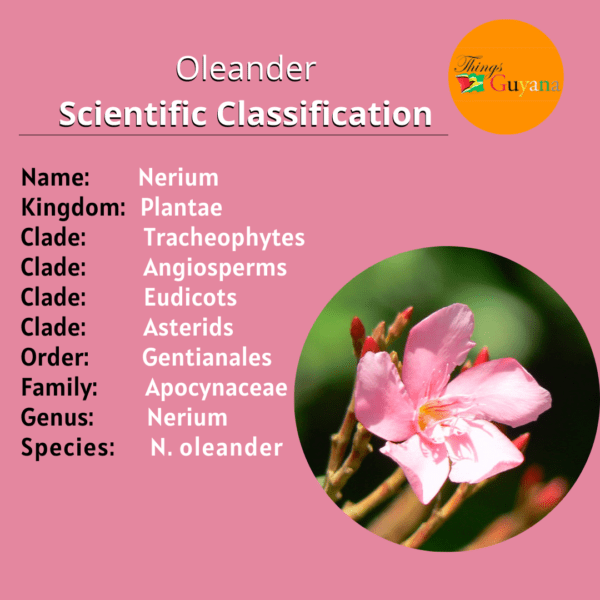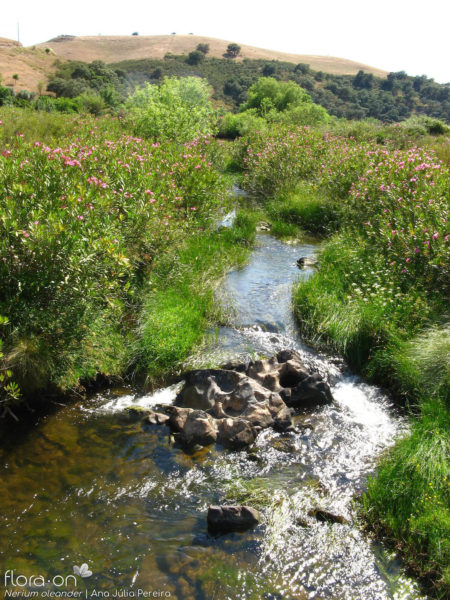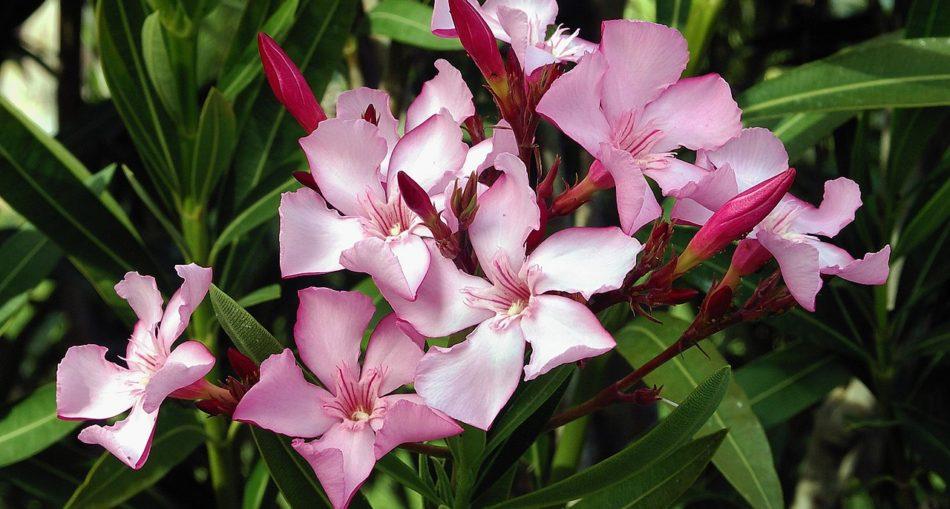Growing up we have always had oleander plants growing in our yard, the beautiful pink, and white flowers were eye-catching. I would get yelled at for picking them off and putting them in small vases all over the house. They wilt fairly easily even when placed in water. The petals are soft to the touch and their scent is sweet. It makes for a great decorative plant.

Description
The oleander plant can grow pretty tall and slender. The length of the plant ranges from 3 to 20 feet. Oleanders grow quickly, within a year of planting you can see the plant sprout to 1 to 2 feet in height. The stem is thick and grey. Leaves are thick, dark green, and leathery and usually grow up to 6 inches long. The oleander flowers gather in clusters and come in a variety of colours such as yellow, white, pink, light orange, and red. The flowers give off a lovely fragrance that attracts, not only insects but wandering, humans’ noses. The fruit of the plant is called a capsule and each capsule contains large, fluffy seeds inside.
Etymology
The name ‘Nerium Oleander’ was first assigned by the Swedish botanist Carl Linneaus in 1753. The genus name Nerium is the Latinized form of the ancient Greek name for the plant nẽrion (νήριον), which is in turn derived from the Greek for water, nẽros (νηρός), because of the natural habitat of the oleander along rivers and streams.
Habitat

Oleander plants growing near a river stream. Photo Source: https://flora-on.pt/?q=Nerium
Oleander plants are typically found growing around stream beds and riverways where they can tolerate long seasons of drought and withstand temperature drops of near zero. It is planted all over the world in subtropical and tropical regions.
Fun Fact: The precise origin of the plant is difficult to identify but it has been associated with the Nothern regions of Africa and the Mediterranian.
Toxicity Of Oleanders
The oleander plant is quite toxic when ingested and can end up being lethal depending on the dosage consumed. As little as one leaf can be able to kill a child. The oleander plant has been used in pest control, specifically as rat poison. All parts of the nerium oleander are poisonous, primarily due to the contained cardiac glycosides—that is, oleandrin, nerin, digitoxigenin, and olinerin of which oleandrin is the principal toxin. Symptoms of oleander poisoning include vomiting, diarrhea, irregular heartbeat, dizziness, and seizures. Besides being ingested you can also be poisoned if you inhale the smoke of a burning oleander plant.
Not-So-Fun Fun Fact – In Sri Lanka the oleander plant has been reported to be a suicide agent and poisonings have exceeded over 150 per 100,000 every year.
Medicinal Uses
As toxic as the oleander plant is those chemicals found inside can also be used for good. There are many promising medical benefits of the oleander plant.
Oleander plant can be used for treating heart conditions, asthma, cancer, malaria, and certain skin conditions such as ringworm. The leaves of the plant have traditionally been used to make poultices (Read more about poultices by clicking here – https://www.thingsguyana.com/poultice-the-ancient-home-remedy-for-boils/ ); when the leaves are grounded and mixed with honey they can be applied to the skin to treat inflammation.
Fun Facts
- Polka-Dot Wasp Moth is a type of insect that consumes oleander without visible side effects.
- Common Crow Butterfly consumes oleander during the larval stage. By storing toxins in the body, this animal increases its chances of survival.
- Despite their toxicity, there are over 300 varieties of oleander that are grown for their decorative properties.
- Oleander is the official flower of Hiroshima. It was the first plant that managed to blossom after the devastating effects produced by the atomic bomb in 1945.
- Oleander can be easily cultivated and it can survive for decades.
Oleander in Mythology
In Greek Myth, the oleander is associated with charm and romance. The origin of the name is said to have come from a young man called Leander whose divine passion for his love for his lover, Hero (a priestess of Aphrodite) ended in tragedy.
One night, while trying to reach a blossom of the plant for his lady, he drowned. In the morning, his lady with longing in her heart was seen and heard crying “O Leander, O Leander!” His body was found with these flowers still clasped in his hands and so these sweet blossoms became a symbol of everlasting love.

Hero and Leander painting by Jan van den Hoecke. Photo Source: https://en.wikipedia.org/wiki/Hero_and_Leander#/media/File:Jan_van_den_Hoecke_-_Hero_laments_the_dead_Leander.jpg
References:
- http://oleander.org/folklore/#:~:text=In%20keeping%20with%20the%20Mediterranean,was%20drowned%20in%20a%20Tempest.
- https://en.wikipedia.org/wiki/Nerium
- https://adc.bmj.com/content/84/1/9
- https://www.softschools.com/facts/plants/oleander_facts/641/#:~:text=Oleander%20is%20an%20evergreen%20plant,poisonous%20plants%20on%20the%20planet.
- https://www.rxlist.com/oleander/supplements.htm#:~:text=Despite%20the%20danger%2C%20oleander%20seeds,disease%3B%20and%20to%20cause%20abortions.







